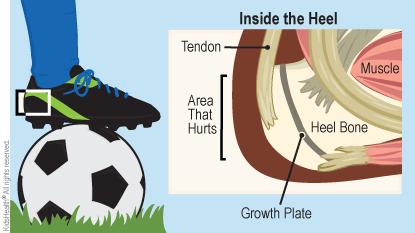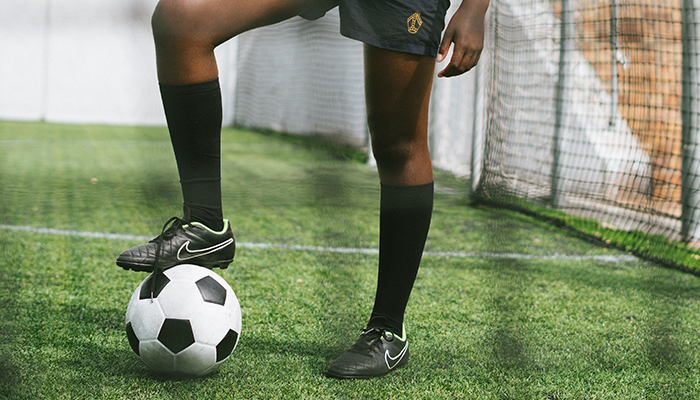Thanks to the COVID-19 vaccine and plummeting COVID-19 cases our kids are back to playing sports full force, yay! With this increase in activity I have been seeing a lot more sports related injuries this spring. There are two common causes of heel and knee pain that are unique to children and teenagers because they involve stress to their growth plates.
Sever’s disease is a common cause of heel pain in children ages 8-12 years. Girls tend to have symptoms earlier than boys. Sever’s disease, otherwise known as calcaneal apophysitis, is caused when the Achilles tendon pulls on the growth plate (apophysitis) on the back of the heel bone (calcaneous). The repetitive pulling and stress on the growth plate causes inflammation and pain on the back of the heel. The pain can come and go and typically gets worse during growth spurts when the bones are growing faster than the tendons. The pain is seen more frequently in sports with a lot of jumping and running and can be made worse by certain types of footwear such as soccer cleats and flip flops. Thankfully, Sever’s disease does not lead to any long-term damage and kids will outgrow this when their growth plates close. But, it can be quite painful so it is important to manage the pain when it is flaring so you can keep your young athlete playing.

So what can you do to help your young athlete with Sever’s disease? Make sure they have supportive proper fitting shoes. Gel heel cups can be bought at the pharmacy and can be put in shoes to help to cushion the heel. When pain flares it is important to rest until your child is feeling better. If they try to play through the pain, that is going to create more inflammation and make the pain worse. Icing the back of the heel after activity for 20 minutes can help along with ibuprofen when the pain is moderate to severe. Calf stretches help to keep the Achilles tendon loose.
Osgood-Schlatter disease is a similar growth plate problem in the knee. Osgood-Schlatter’s causes pain in the front of the knee, just below the knee cap over a bump on the lower leg bone called the tibial tuberosity. This bump on the tibia is where the patellar tendon (knee cap) attaches to the bone. Similar to Sever’s, there is a growth plate there and when the knee flexes the tendon pulls on the growth plate and can cause inflammation and pain. It is common to see visible swelling over the tibial tuberosity and this bump can be painful to touch. This is typically a problem in children ages 9-14 years. Repetitive pounding movements tend to make this pain worse. It is commonly seen in kids who play basketball, football, soccer and gymnastics.

Osgood-Schlatter does not cause long-term knee damage. But, it can be quite painful and limit participation in sports and activities. The treatment for Osgood-Schlatter is similar to the treatment of Sever’s disease with ice, ibuprofen and rest. The pain typically resolves on its own when the growth plate closes, but the swelling and bump may take a long time to return to normal. These are two common causes of chronic knee and foot pain in growing kids. But, there are many other causes. If pain is slowing your kid down, we’d be happy to see them in clinic to help to find the cause and get your child back on the field playing!

Leave a Reply